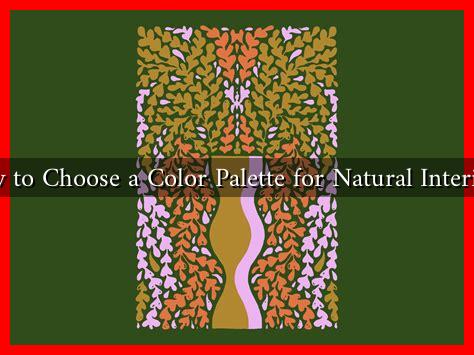-
Table of Contents
How to Choose a Color Palette for Natural Interiors
Creating a harmonious and inviting space in your home often begins with selecting the right color palette. Natural interiors, characterized by their earthy tones and organic materials, can evoke a sense of calm and connection to nature. This article will guide you through the process of choosing a color palette that enhances the beauty of natural interiors, ensuring your space feels cohesive and serene.
Understanding the Basics of Color Theory
Before diving into color selection, it’s essential to grasp the fundamentals of color theory. Colors can be categorized into three primary groups:
- Primary Colors: Red, blue, and yellow are the building blocks of all other colors.
- Secondary Colors: Created by mixing primary colors, these include green, orange, and purple.
- Tertiary Colors: These are formed by mixing primary and secondary colors, resulting in hues like red-orange and blue-green.
Understanding these categories can help you create a balanced color palette that feels natural and inviting.
Choosing a Color Palette for Natural Interiors
When selecting a color palette for natural interiors, consider the following steps:
1. Draw Inspiration from Nature
Nature is an endless source of inspiration for color palettes. Look to your surroundings—forests, mountains, oceans, and even urban parks. Here are some ideas:
- Forest Greens: Incorporate various shades of green, from deep emerald to soft sage.
- Earthy Browns: Use warm browns reminiscent of tree bark or soil.
- Sky Blues: Soft blues can evoke the tranquility of a clear sky.
By mimicking the colors found in nature, you can create a soothing environment that feels grounded and organic.
2. Consider the Mood You Want to Create
The colors you choose can significantly impact the mood of your space. Here are some common associations:
- Warm Colors: Reds, oranges, and yellows can create a cozy and inviting atmosphere.
- Cool Colors: Blues and greens tend to evoke calmness and relaxation.
- Neutral Colors: Whites, grays, and beiges provide a versatile backdrop that can make a space feel open and airy.
Decide on the mood you want to achieve and select colors that align with that vision.
3. Use the 60-30-10 Rule
The 60-30-10 rule is a classic guideline for creating a balanced color scheme:
- 60% Dominant Color: This is the main color that will cover the majority of the space, such as walls or large furniture.
- 30% Secondary Color: This color complements the dominant color and can be used for upholstery or curtains.
- 10% Accent Color: A bold color that adds interest and can be used in accessories like cushions or artwork.
This rule helps ensure that your color palette is well-balanced and visually appealing.
Case Studies: Successful Natural Interiors
Several designers have successfully implemented natural color palettes in their projects. For instance, the renowned interior designer Kelly Wearstler often uses earthy tones and textures to create spaces that feel both luxurious and grounded. Her use of natural materials, such as wood and stone, combined with a muted color palette, exemplifies how to achieve a harmonious natural interior.
Another example is the minimalist approach taken by Tadao Ando, who utilizes simple color schemes that reflect the surrounding landscape, creating a seamless transition between indoor and outdoor spaces.
Conclusion
Choosing a color palette for natural interiors is a thoughtful process that involves understanding color theory, drawing inspiration from nature, and considering the mood you wish to create. By following the 60-30-10 rule and looking at successful case studies, you can develop a cohesive and inviting space that reflects the beauty of the natural world. Remember, the right colors can transform your home into a sanctuary that promotes relaxation and well-being.

